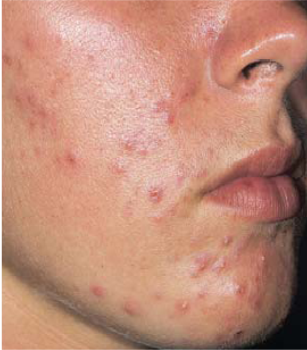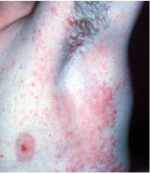|
Objectives
Discuss common skin
conditions
Basic management
You as a primary care
provider
Highlight patient
education
Pitfalls &
Mismanagement
Recognize skin cancers
When to refer to
dermatology
Recommended
References
Clinical Dermatology, 4th
ed
Thomas P. Habif
ISBN: 3323013198
Color Atlas & Synopsis of
Clinical Dermatology
Thomas B. Fitzpatrick,
et al.
ISBN: 0071360387
|
 Acne
Disease of the
pilosebaceous units
Hormonally influenced
Disfiguring
Acne Classification
Comedonal
Non-inflammatory
Whiteheads
Blackheads
Inflammatory
Red papules
Pustules
Nodulocystic
Comedonal acne
Inflammatory acne – Mild
Inflammatory acne –
Moderate
Nodulocystic acne
Other involved areas
Treatment
Good MILD
skin care
mild soaps
gentle washing
No facial scrubs
– BAD, BAD, BAD
Acne comes from within
Not from dirt
Not from foods
Comedonal Acne
Start with low dose retinoid
Retin-A 0.05% cream
Switch to Retin-A micro
0.04%
after several weeks
or when adjusted
Benzoyl peroxide 5%
gel/wash
+/- topical antibiotics
Cleocin T lotion or gel
Retinoids
Reduces keratinocyte
cohesion
Opens plugged pores
Prevents plugging
Problems
Irritating
Photosensitizing
Retinoids
To avoid irritation:
Go easy in the beginning
Use lower strength to start
(creams, low %)
Use 2 nights per week
Increase as tolerated to
nightly use
Apply on very dry face
Wash face, then wait 15-20
minutes
Avoid moist areas
nasal folds, periorbit,
oral commissures
Retinoids
Apply only at night
Photosensitivity
Use mild non-comedogenic
moisturizer in the morning with SPF 15-30
Patient education
Acne will get worse before it
gets better
Should continue even though
face clears
Retinoids
Retin A
Cream 0.025%, 0.05%, 0.1%
Gel 0.01%, 0.025%
Micro 0.04%, 0.1%
Differin gel
Tazorac
This is KEY to long term
acne tx!
Benzoyl Peroxide
Antibacterial
Minimizes bacterial resistance
Mild peeling effect
Bleaches colored cloth
5% wash or gel
Inflammatory acne – Mild
Dry face with topical
antibiotics first
Cleocin T gel/lotion x 2-3
weeks
Introduce retinoids
Retin-A 0.05% cream
Switch to Retin-A micro 0.04%
after several weeks
or when adjusted
Continue topical antibiotics
Benzoyl peroxide 5% wash
Continue to PowerPoint® Lecture...
Lecture by LCDR Will Lumbang
2006 Surface Warfare Medical Officer Indoctrination Course
Naval Operational Medicine Institute
340 Huise Road
Pensacola FL 32508-1092
|


